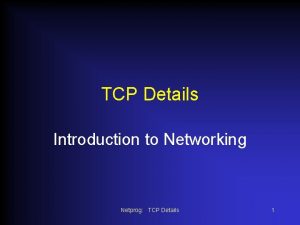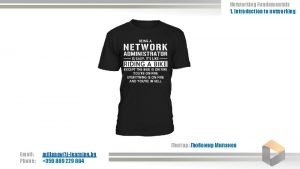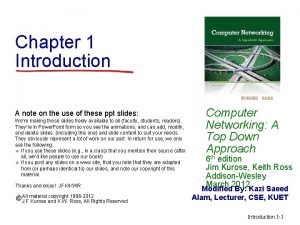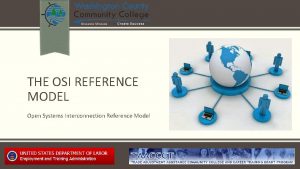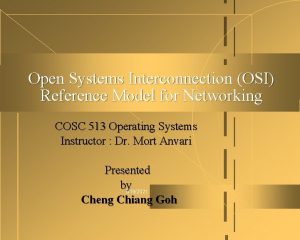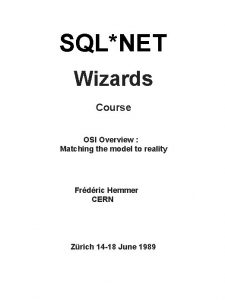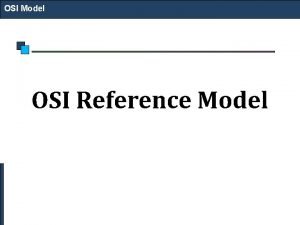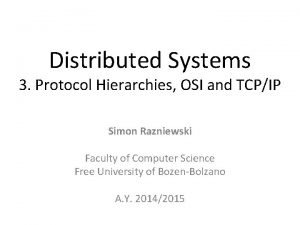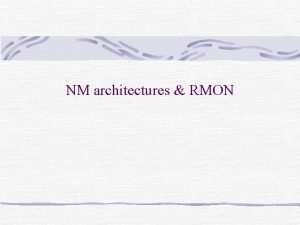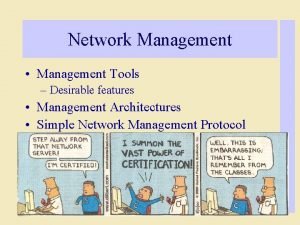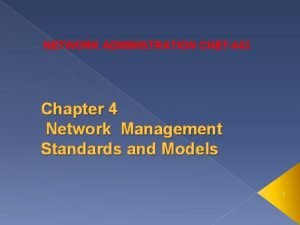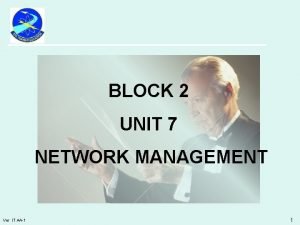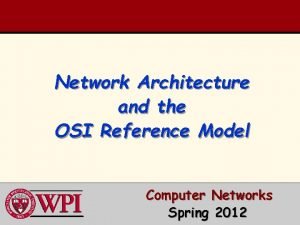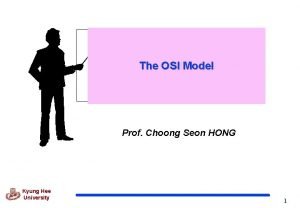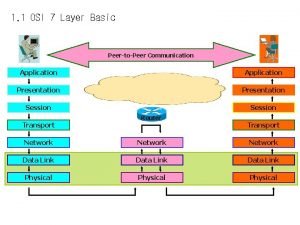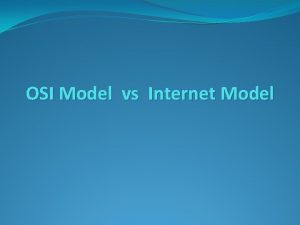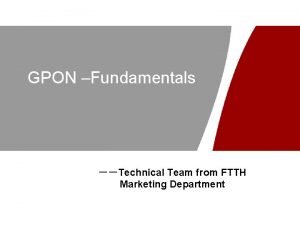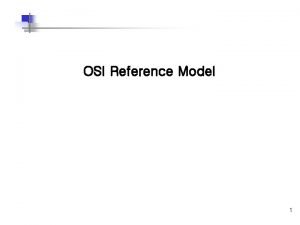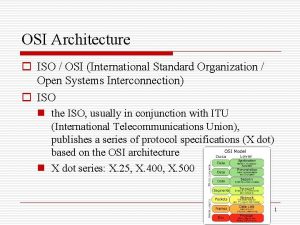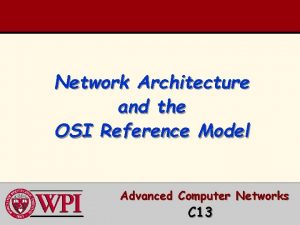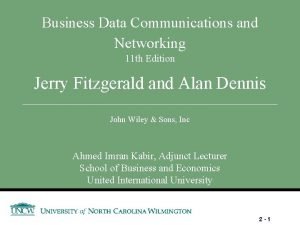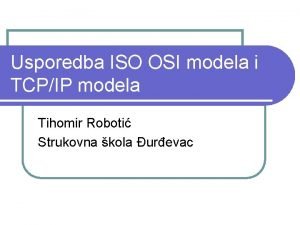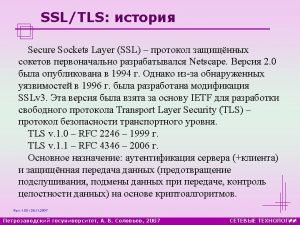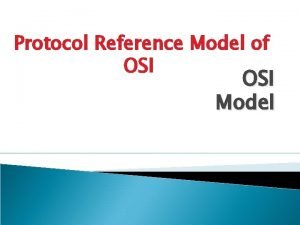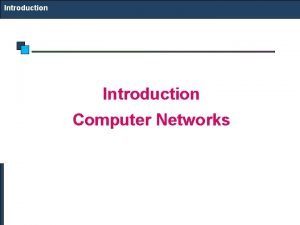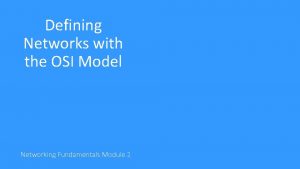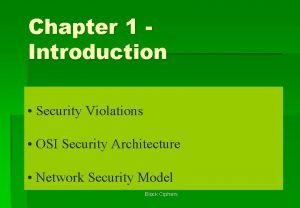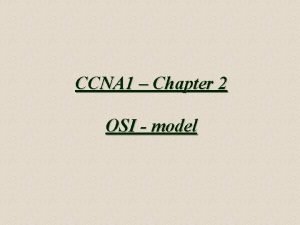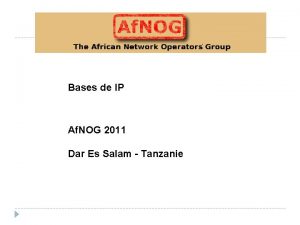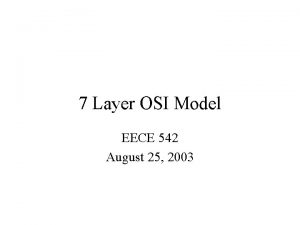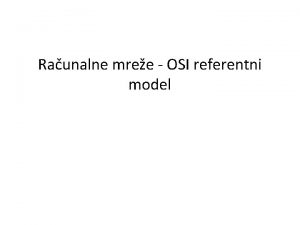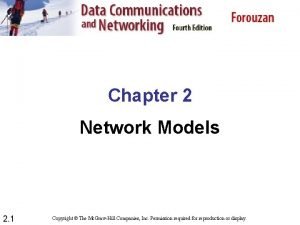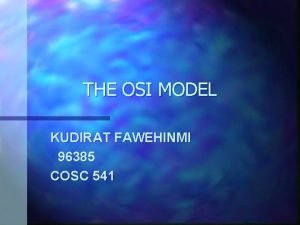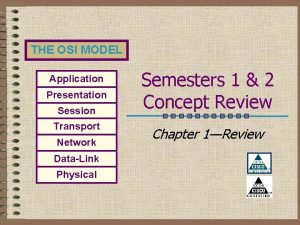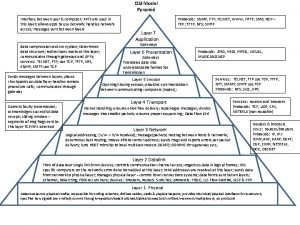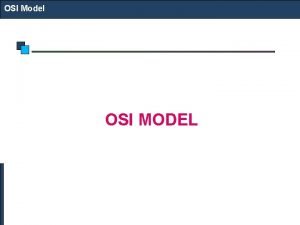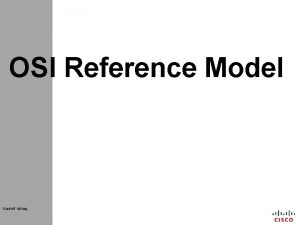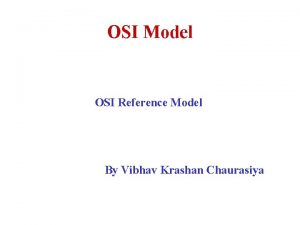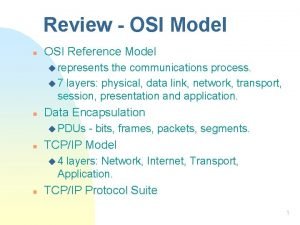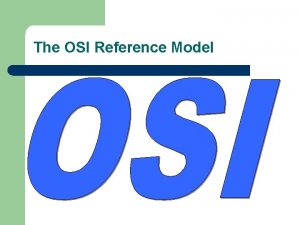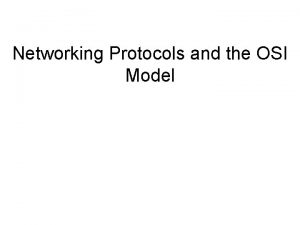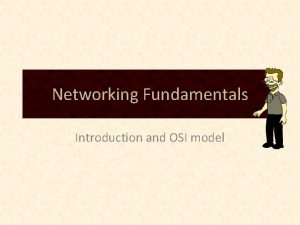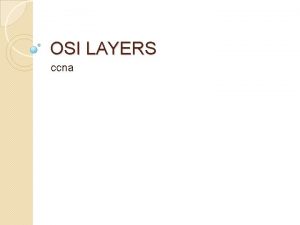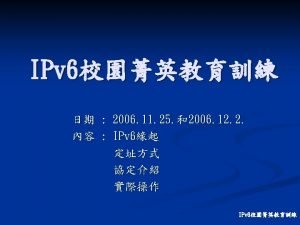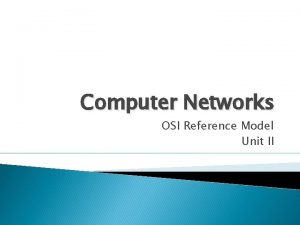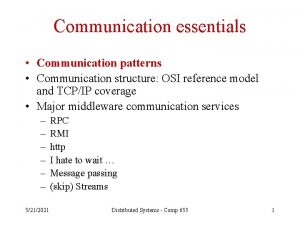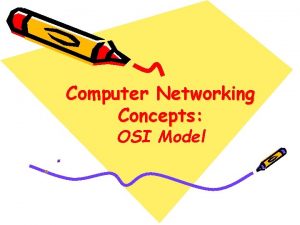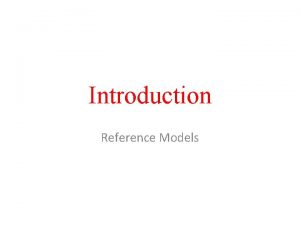Networking Netprog OSI Reference Model 1 Network communication


















































- Slides: 50

Networking Netprog: OSI Reference Model 1

Network “. . . communication system for connecting end-systems” End-systems a. k. a. “hosts” PCs, workstations dedicated computers network components Netprog: OSI Reference Model 2

Multi-access vs. Point-to-point n Multi-access means shared medium. – Many end-systems share the same physical communication resources (wire, frequency, . . . ) – There must be some arbitration mechanism. n Point-to-point – only 2 systems involved – no doubt about where data came from ! Netprog: OSI Reference Model 3

Multi-access Point-to-point Netprog: OSI Reference Model 4

LAN - Local Area Network n Connects computers that are physically close together ( < 1 mile). – high speed – multi-access n Technologies: – Ethernet 10 Mbps, 100 Mbps – Token Ring 16 Mbps – FDDI (Fiber Distributed Data Interface) 100 Mbps Netprog: OSI Reference Model 5

WAN - Wide Area Network n Connects computers that are physically far apart. “long-haul network”. – typically slower than a LAN. – typically less reliable than a LAN. n Technologies: – telephone lines – satellite communications Netprog: OSI Reference Model 6

MAN - Metropolitan Area Network n Larger than a LAN and smaller than a WAN - example: campus-wide network - multi-access network n Technologies: – coaxial cable – microwave Netprog: OSI Reference Model 7

Internetwork Connection of 2 or more distinct (possibly dissimilar) networks. n Requires some kind of network device to facilitate the connection. n Net A Net B Netprog: OSI Reference Model 8

OSI Reference Model n Layered model: 7. Application 6. Presentation 5. Session 4. Transport 3. Network 2. Data Link 1. Physical Netprog: OSI Reference Model 9

The Physical Layer n Responsibility: – transmission of raw bits over a communication channel. n Issues: – mechanical and electrical interfaces – time per bit – distances Netprog: OSI Reference Model 10

The Data Link Layer Logical Link Control (LLC) n Responsibility: – Provides multiplexing and flow control mechanisms that make it possible for several network protocols to coexist within a multipoint network and to be transported over the same network media. n Issues: v Multiplexing protocols transmitted over the MAC layer (when transmitting) and decoding them (when receiving). Providing flow and error control v Netprog: OSI Reference Model 11

The Data Link Layer The MAC sublayer n Medium Access Control ― make it possible for several network nodes to communicate within a multipoint network v v n Addressing Channel access control MAC provides DLC with “virtual wires” on multiaccess networks. Netprog: OSI Reference Model 12

The Network Layer n Responsibilities: – path selection between end-systems (routing). – subnet flow control. – fragmentation & reassembly – translation between different network types. n Issues: – packet headers – virtual circuits Netprog: OSI Reference Model 13

The Transport Layer n Responsibilities: – provides virtual end-to-end links between peer processes. – end-to-end flow control n Issues: – headers – error detection – reliable communication Netprog: OSI Reference Model 14

The Session Layer n Responsibilities: – establishes, manages, and terminates sessions between applications. – service location lookup n Many protocol suites do not include a session layer. Netprog: OSI Reference Model 15

The Presentation Layer n Responsibilities: – data encryption – data compression – data conversion n Many protocol suites do not include a Presentation Layer. Netprog: OSI Reference Model 16

The Application Layer n Responsibilities: – anything not provided by any of the other layers n Issues: – application level protocols – appropriate selection of “type of service” Netprog: OSI Reference Model 17

Layering & Headers Each layer needs to add some control information to the data in order to do it’s job. n This information is typically prepended to the data before being given to the lower layer. n Once the lower layers deliver the data and control information - the peer layer uses the control information. n Netprog: OSI Reference Model 18

Headers DATA Process H DATA Transport H H DATA Network H H H DATA Data Link Process Transport Network Data Link Netprog: OSI Reference Model 19

What are the headers? Physical: no header - just a bunch of bits. Data Link: – address of the receiving endpoints – address of the sending endpoint – length of the data – checksum. Netprog: OSI Reference Model 20

Network layer header examples protocol suite version n type of service n length of the data n packet identifier n fragment number n time to live n protocol n header checksum n source network address n destination network address n Netprog: OSI Reference Model 21

Important Summary Data-Link: communication between machines on the same network. n Network: communication between machines on possibly different networks. n Transport: communication between processes (running on machines on possibly different networks). n Netprog: OSI Reference Model 22

Connecting Networks n Repeater: physical layer n Bridge: data link layer n Router: network layer n Gateway: network layer and above. Netprog: OSI Reference Model 23

Repeater Copies bits from one network to another n Does not look at any bits n Allows the extension of a network beyond physical length limitations n REPEATER Netprog: OSI Reference Model 24

Bridge Copies frames from one network to another n Can operate selectively - does not copy all frames (must look at data-link headers). n Extends the network beyond physical length limitations. n BRIDGE Netprog: OSI Reference Model 25

Router Copies packets from one network to another. n Makes decisions about what route a packet should take (looks at network headers). n ROUTER Netprog: OSI Reference Model 26

Gateway Operates as a router n Data conversions above the network layer. n Conversions: n encapsulation - use an intermediate network translation - connect different application protocols encrpyption - could be done by a gateway Netprog: OSI Reference Model 27

Encapsulation Example Gateway n Gateway Provides service connectivity even though intermediate network does not support protocols. Netprog: OSI Reference Model 28

Translation Gateway n Translate from green protocol to brown protocol Netprog: OSI Reference Model 29

Encryption gateway Secure Network Encryption/Decryption Gateways GW ? ? ? Secure Network GW Insecure Network Netprog: OSI Reference Model 30

Hardware vs. Software Repeaters are typically hardware devices. n Bridges can be implemented in hardware or software. n Routers & Gateways are typically implemented in software so that they can be extended to handle new protocols. n Many workstations can operate as routers or gateways. n Netprog: OSI Reference Model 31

Byte Ordering Different computer architectures use different byte ordering to represent multibyte values. n 16 bit integer: n Low Byte High Byte Address A+1 Netprog: OSI Reference Model High Byte Low Byte 32

Byte Ordering Little-Endian Big-Endian Low Byte High Byte Low Byte Addr A+1 IBM 80 x 86 DEC VAX DEC PDP-11 IBM 370 Motorola 68000 Sun Netprog: OSI Reference Model 33

Byte Order and Networking n Suppose a Big Endian machine sends a 16 bit integer with the value 2: 000000010 n A Little Endian machine will think it got the number 512: 000000100000 Netprog: OSI Reference Model 34

Network Byte Order n n Conversion of application-level data is left up to the presentation layer. How do lower level layers communicate if they all represent values differently ? Networks generally use big-endian order. A fixed byte order is used (called network byte order) for all control data. In networking, the decision about the order of transmissions of bits is made in the very bottom of the data link layer of the OSI model Netprog: OSI Reference Model 35

Multiplexing “. . to combine many into one”. n Many processes sharing a single network interface. n A single process could use multiple protocols. n More on this when we look at TCP/IP. n Netprog: OSI Reference Model 36

Modes of Service connection-oriented vs. connectionless n sequencing n error-control n flow-control n byte stream vs. message based n full-duplex vs. half-duplex. n Netprog: OSI Reference Model 37

Connection-Oriented vs. Connectionless Service n A connection-oriented service includes the establishment of a logical connection between 2 processes. – establish logical connection – transfer data – terminate connection. n Connectionless services involve sending of independent messages. Netprog: OSI Reference Model 38

Sequencing provides support for an order to communications. n A service that includes sequencing requires that messages (or bytes) are received in the same order they are sent. n Netprog: OSI Reference Model 39

Error Control Some services require error detection (it is important to know when a transmission error has occured). n Checksums provide a simple error detection mechanism. n Error control sometimes involves notification and retransmission. n Netprog: OSI Reference Model 40

Flow Control Flow control prevents the sending process from overwhelming the receiving process. n Flow control can be handled a variety of ways - this is one of the major research issues in the development of the next generation of networks. n Netprog: OSI Reference Model 41

Byte Stream vs. Message Byte stream implies an ordered sequence of bytes with no message boundaries. n Message oriented services provide communication service to chunks of data called datagrams. n Netprog: OSI Reference Model 42

Full- vs. Half-Duplex n Full-Duplex services support the transfer of data in both directions. n Half-Duplex services support the transfer of data in a single direction. Netprog: OSI Reference Model 43

End-to-End vs. Hop-by-Hop n Many service modes/features such as flow control and error control can be done either: between endpoints of the communication. -orbetween every 2 nodes on the path between the endpoints. Netprog: OSI Reference Model 44

End-to-End Process A Process B Netprog: OSI Reference Model 45

Hop-by-Hop Process A Process B Netprog: OSI Reference Model 46

Buffering can provide more efficient communications. n Buffering is most useful for byte stream services. n Process A Send Buffer Recv. Buffer Netprog: OSI Reference Model Process B 47

Addresses Each communication endpoint must have an address. n Consider 2 processes communicating over an internet: n – the network must be specified – the host (end-system) must be specified – the process must be specified. Netprog: OSI Reference Model 48

Addresses at Layers n Physical Layer: no address necessary n Data Link Layer - address must be able to select any host on the network. n Network Layer - address must be able to provide information to enable routing. n Transport Layer - address must identify the destination process. Netprog: OSI Reference Model 49

Broadcasts Many networks support the notion of sending a message from one host to all other hosts on the network. n A special address called the “broadcast address” is often used. n Netprog: OSI Reference Model 50
 Netprog
Netprog Networking osi model
Networking osi model Traditional network vs sdn
Traditional network vs sdn Osi model in computer networks
Osi model in computer networks They relay packets among multiple interconnected networks
They relay packets among multiple interconnected networks Open system interconnection reference model
Open system interconnection reference model Disadvantages of osi reference model
Disadvantages of osi reference model Upiopi
Upiopi Osi model
Osi model Osi reference model
Osi reference model Snmp model in computer networks
Snmp model in computer networks Osi network management model
Osi network management model Cmip network management
Cmip network management Toptook
Toptook Osi network management model
Osi network management model Imon internet outage
Imon internet outage Osi architecture
Osi architecture Osi network management model
Osi network management model Network layer in osi model
Network layer in osi model Peer-to-peer communication in osi model
Peer-to-peer communication in osi model Osi model vs internet model
Osi model vs internet model Gpon frame structure
Gpon frame structure Business data communications and networking
Business data communications and networking Computer network assignment
Computer network assignment Osi security architecture in network security
Osi security architecture in network security The basic unit of a physical network (osi layer 1) is the:
The basic unit of a physical network (osi layer 1) is the: Iso file
Iso file Osi network architecture
Osi network architecture Osi network architecture
Osi network architecture Osi model
Osi model Reference node and non reference node
Reference node and non reference node Reference node and non reference node
Reference node and non reference node The five layer networking model
The five layer networking model Iso osi model
Iso osi model History of the osi model
History of the osi model Ssl osi model
Ssl osi model Osi model conclusion
Osi model conclusion Iso osi layers
Iso osi layers Encapsulation and decapsulation in osi model
Encapsulation and decapsulation in osi model Which layer in the osi model covers http, ftp, and rdc?
Which layer in the osi model covers http, ftp, and rdc? X.800 security architecture
X.800 security architecture Osi model ccna
Osi model ccna Encapsulation decapsulation osi model
Encapsulation decapsulation osi model Encapsulation and decapsulation in osi model
Encapsulation and decapsulation in osi model Slojevi osi modela
Slojevi osi modela Seven layers of the osi model
Seven layers of the osi model Conclusion of osi model
Conclusion of osi model Application presentation session
Application presentation session Osi modelis
Osi modelis Modeli osi
Modeli osi Osi pyramid
Osi pyramid
